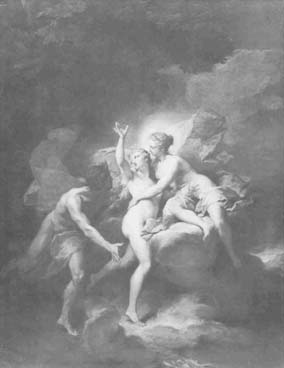
Annual Bulletin 6, 1982-1983
Home
Français
Introduction
History
Annual Index
Author &
Subject
Credits
Contact

Paintings
by Restout on Mythological and Historical Themes: Acquisition by the
National Gallery of Canada of Venus Presenting Arms to Aeneas
by Pierre Rosenberg and Antoine Schnapper
Pages 1 | 2
| 3
| 4
The other argument can
be drawn from the second part of the 1771 article, that is that
Jouvenet's influence is more perceptible in the Ségoura canvas
than in the Ottawa one, which has a much more personal style. In the
Ségoura painting, the pose of Vulcan resting an elbow on his
workbench, the large plank attached to the wall, and the
bare-breasted Venus, are all taken from a painting on the same theme
exhibited by Jouvenet at the 1699 and 1704 Salons. This painting is
known primarily through a print by L. Desplaces. (15) The helmet
resting on the table, the dog, the descriptive realism given to the
details of the furniture, stressed by the light, are all pure
Jouvenet. Conversely, not many people would see a
"reincarnation of Jouvenet" in the Ottawa painting, where
Jouvenet's influence is much more subdued and is really apparent
only in the details (the heads of the putti, the rendering
of the clouds and the hands, the raised shoulder of Aeneas, and so
on). Oddly enough, there are none of the slender forms which are so
striking in the Ségoura painting and which are also present in Alpheus
and Arethusa painted as a reception piece in 1720. (fig. 4).
Need it be said that, but for the inscription on the back of the
Ottawa canvas, we would have suggested a later date for it. The
preparatory drawing for the Ségoura painting, which resurfaced in
197716 (fig. 5), shows much more independence from Jouvenet and has
a much more personal style than does the completed work.
What is the answer then? There is a coincidence which might be
significant: both canvases are the same size (although the height
and width are transposed), and both appear to come from
Switzerland. Could it be that, in order to prepare for the grand
prize, Restout painted two complementary works, on two related
subjects, in two different styles - one of which, if not both -
gained
him admission to the Academy as an associate member? The grand prize
was made more formal in 1717, thanks to the generosity of the
Surintendant, the Duc d'Antin, announced on 23 May 1716. The
students were informed that they would have to prepare themselves on
20 March 1717; however, Restout was not one of the four finalists on
24 April. (17)
Like Jouvenet, Restout concentrated mainly on church paintings;
but, as the 1771 article so elegantly put it, "However, from
time to time he tempered the nobility of his chalk and enriched
private collections." Some of these mythological and historical
paintings have surfaced since 1970, and we would now like to publish
them as well.
To do this, we will use our 1970 catalogue. It should be
pointed out that this catalogue was composed, on the one hand, of
traditional catalogue entries and, on the other, of a systematic
list, which was to be a complete inventory of all of Restout's
works known in 1970 or mentioned in an eighteenth-century text.
In addition to the twenty-nine compositions with mythological or
historical subjects that were catalogued in 1970 {the list comprised
a total of 143 entries), only one new work has appeared - the Ottawa
piece.
However, a number of changes and additions give reason to re-examine
some of the twenty-nine compositions. To do this, we will use the
numbering system that appeared in our systematic list, which, it
should be noted, was intended to be chronological.
Preserved Paintings
No. 5 This is the Ségoura composition mentioned and
reproduced in fig. 2.
No.8 Diane and Endymion (Hôtel de Ville, Versailles). In
1970, we were unable to obtain a photograph (fig. 6) of this
painting, which dates from 1724.
No.9 Jupiter and Callisto. 1725 [?] and not 1752 [?]. A copy
[?], (fig. 7) graces the prefecture of Châlons-sur-Marne (reported
by Nathalie Volle).
Nos 38 and 39 Abdalonymus Working in his Garden (1737); Abdalonymus
Appearing before Alexander in Royal Dress. For more complete
information on these paintings, see the excellent catalogue by Mary
O'Neill entitled Tableaux français des XVIIe et XVIIIe
siècles du Musée d'Orléans (1981).
No. 74 This painting, signed and dated 1749, belonged to the Mèwes
Collection in 1970. It was judiciously acquired in 1977 (Musées
à Strasbourg, no.1, October, Oecember 1977, shown on the cover)
by the Strasbourg Musée des Beaux-Arts. J. D. Ludmann La Revue du
Louvre...,1979, nos 5-6, pp. 451-452), attempted to prove that
the Strasbourg painting represented not The Deification of Aeneas
but rather Venus Presenting Arms to Aeneas. A comparison
with the Ottawa painting on the one hand {fig. 1), and The
Deification of Aeneas of Le Brun in Montreal Le Brun exhibition
catalogue (Versailles: 1963), no. 5 ill.) on the other, proves that
we correctly identified the theme of the Strasbourg canvas (in fact,
the two events follow one another in Ovid's account). The Caen
museum recently purchased a fine preparatory drawing of this canvas
(Hôtel Drouot sale, Paris, 6 November 1980, no. 100); black chalk
with white highlights on blue paper, squared, with significant
changes made to Venus' face using a flap, 42.5 x 35.2 cm. We are
reproducing here the two "versions" of the drawing (figs 8
and 9).
Next Page | Restout's
Vanished Paintings
1 | 2
| 3
| 4
Annual Index | Author & Subject | Credits | Contact
This digital collection
was produced under contract to Canada's Digital Collections program,
Industry Canada.
"Digital
Collections Program, Copyright
© National Gallery of
Canada 2001"